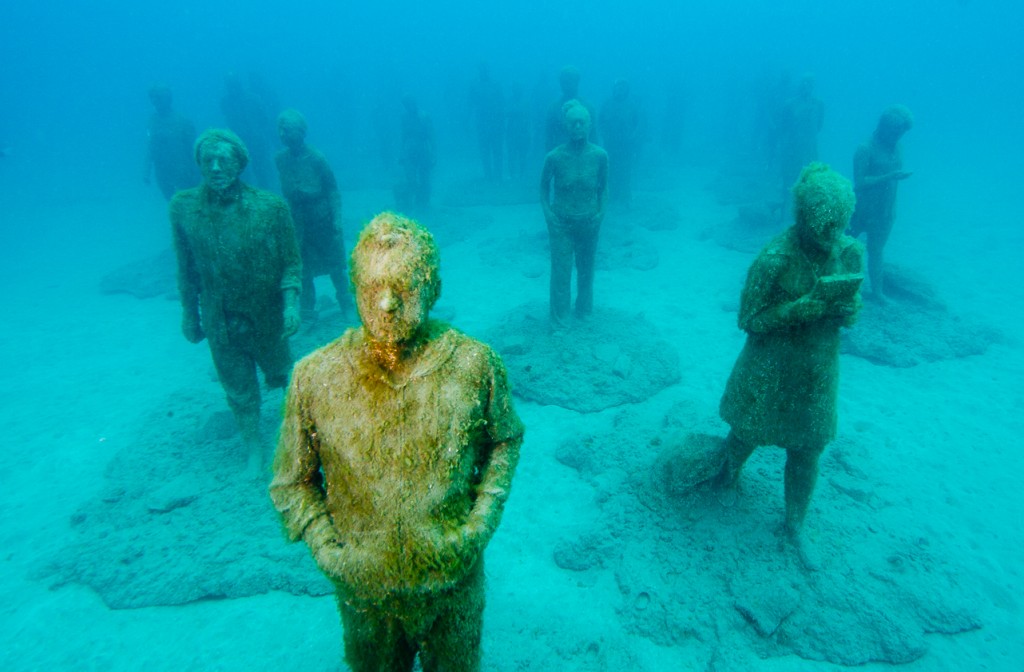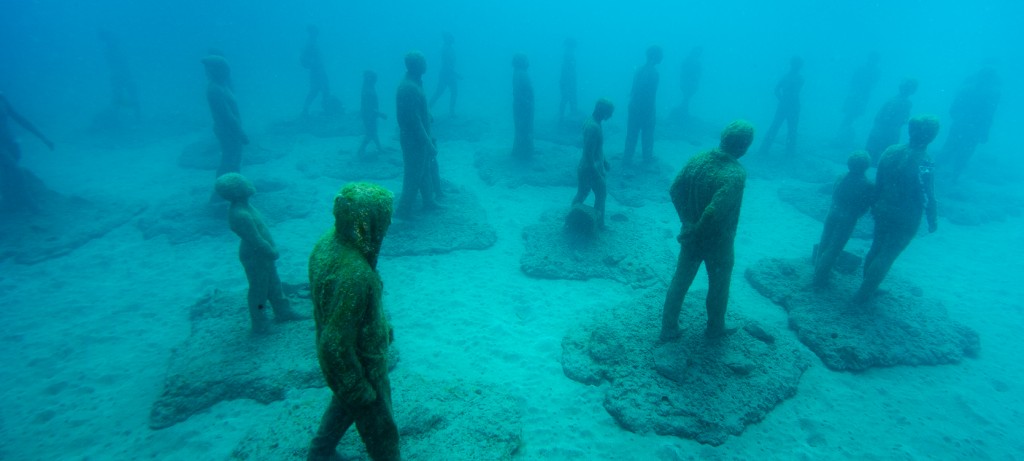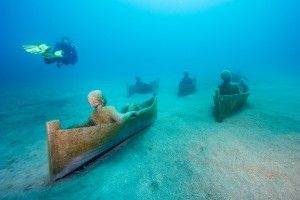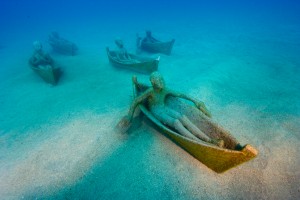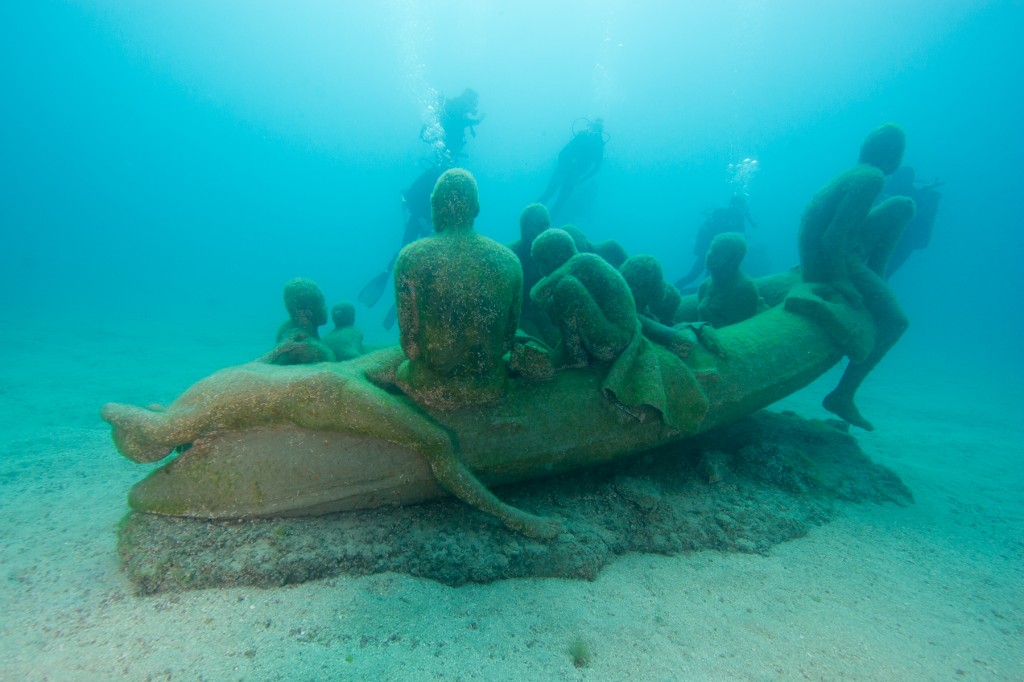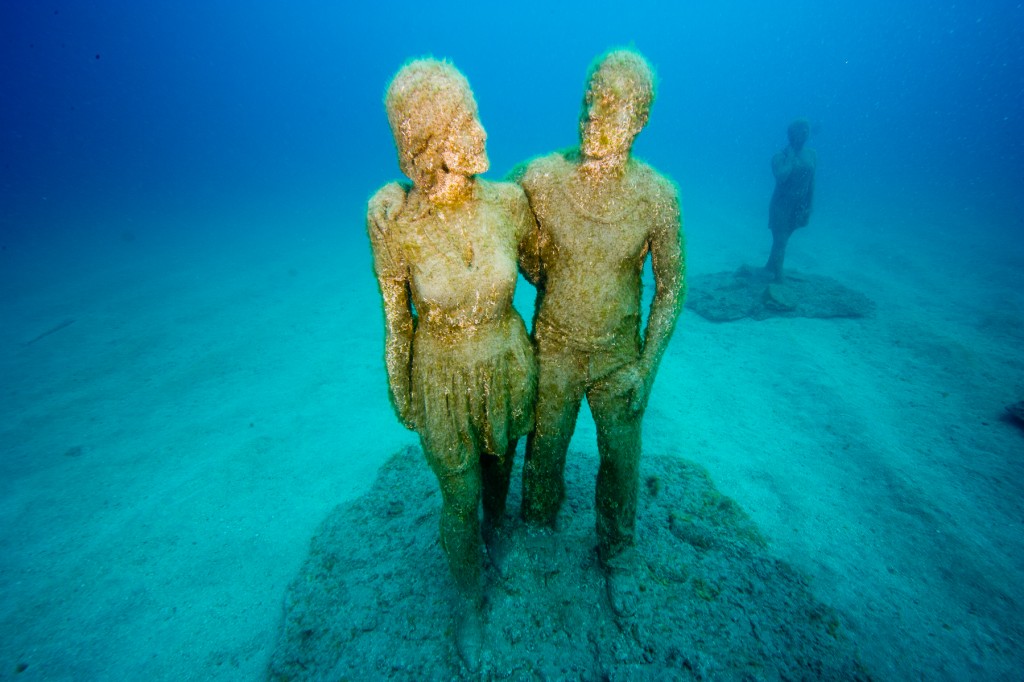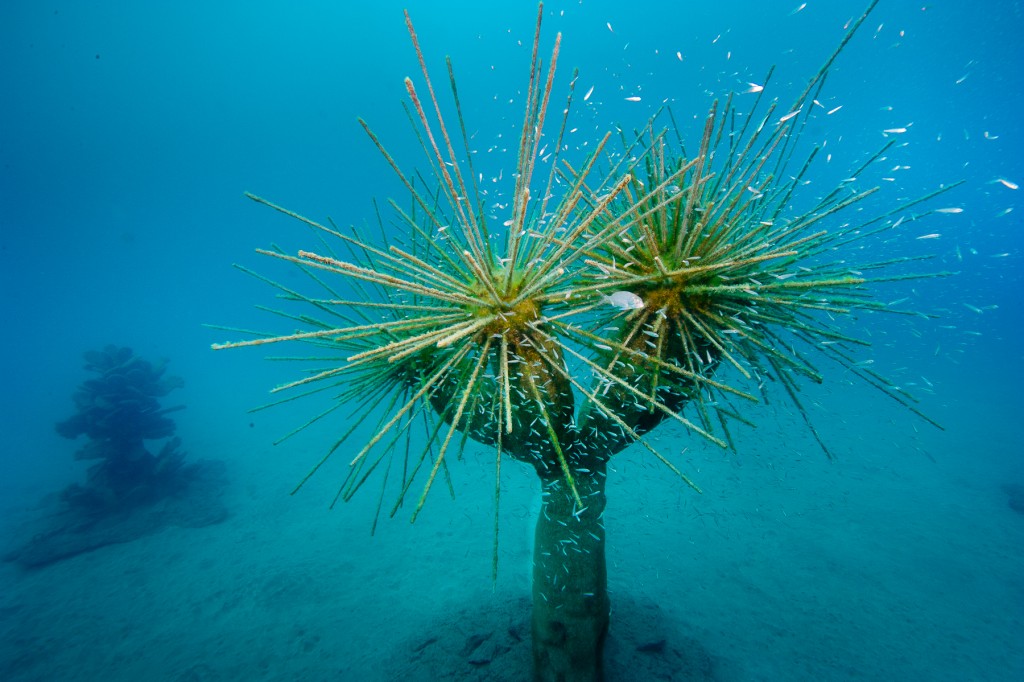News
Zombies vs Aliens: Exploring Europe’s First Underwater Museum
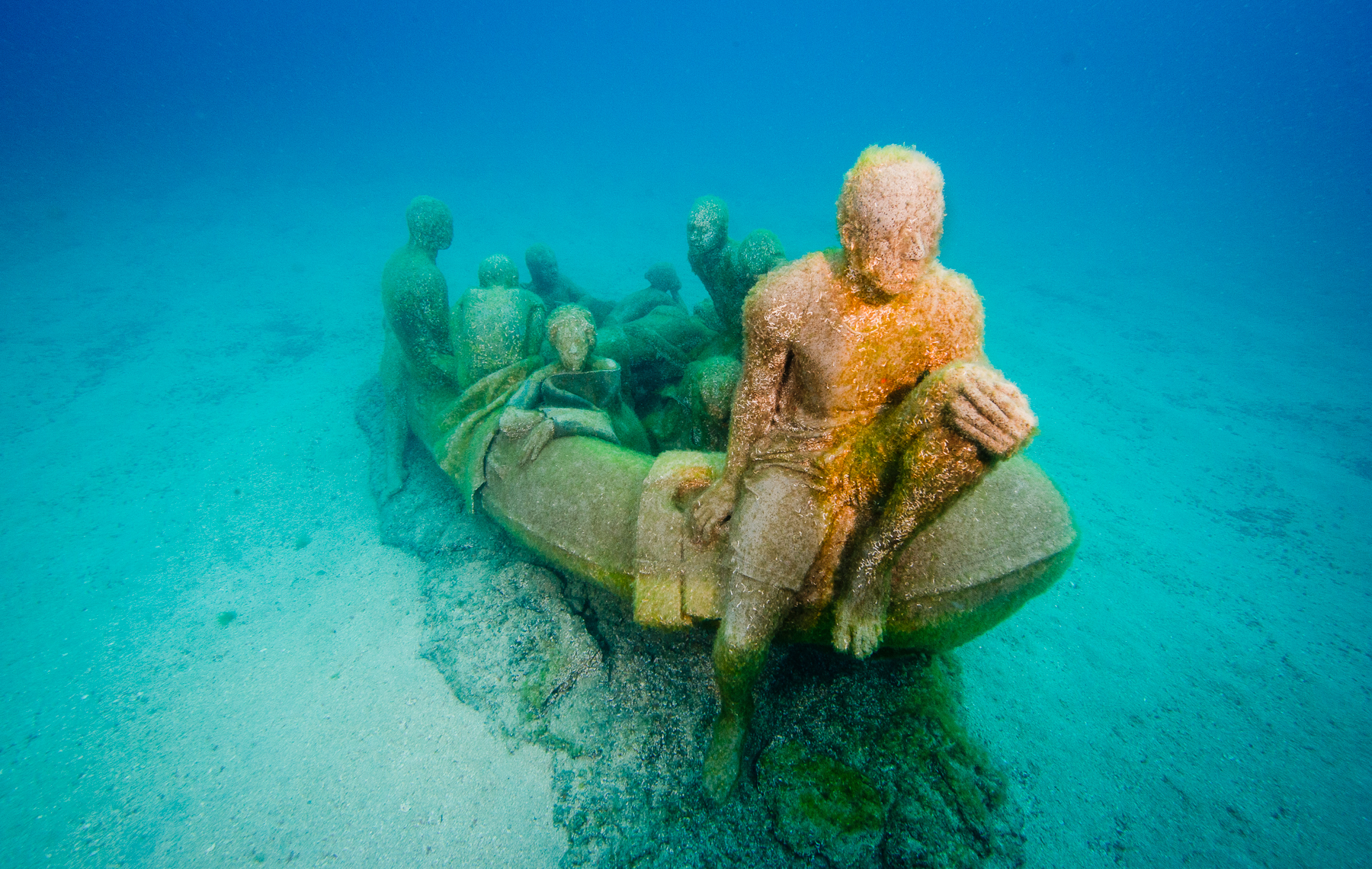
They were lined up like a mini army, an eerie group of the walking dead; zombies from another world. Like some weird catastrophic event – something from a B movie – a whole population on the march, frozen solid in stone and drowned underwater!
But although eerie and zombie like, the statues in front of us were beautiful too, each one uniquely different. A man in a hooded top, a fisherman in a waistcoat and cap, a barefooted lady reading a book, a mother and her young child, and a child on her own gazing up towards the surface. What seemed weird is that these statues looked more at home than we did. They seemed alive and at home where they stood. It was us who were invading their world, breathing air from our tanks and creating streams of bubbles; we were the aliens.
As our guide took us on our tour through Europe’s first underwater museum I was excited about what we’d see next. The first exhibit we were shown was a couple taking a selfie of themselves! Then it was on to a group of traditional dugout canoes manned by young boys. It represented a scene once common on Lanzarote’s shores where boys would paddle out to sea to race each other and to fish.
Our next exhibit was even more topical and relevant. “The Raft of Lampedusa”, a tribute to the refugee crisis and depicting a scene throughout the Mediterranean, that of a small boat packed with whole families including young children risking their lives as they flee from war and persecution to find a safe country to escape too and start a new life all over again. All these exhibits were brilliant and thought provoking in their own right, but the group of statues we were hovering over was the most impressive to me.
As the sun filtered down through the milky somewhat chilly water, they were very evocative, and perhaps the reason they seemed so eerie was down to the less than perfect underwater visibility. We could just see the surface some 15 metres above us, but horizontal visibility was even less and variable and wasn’t helped by the vertical swimming positions of some of the divers in our group.
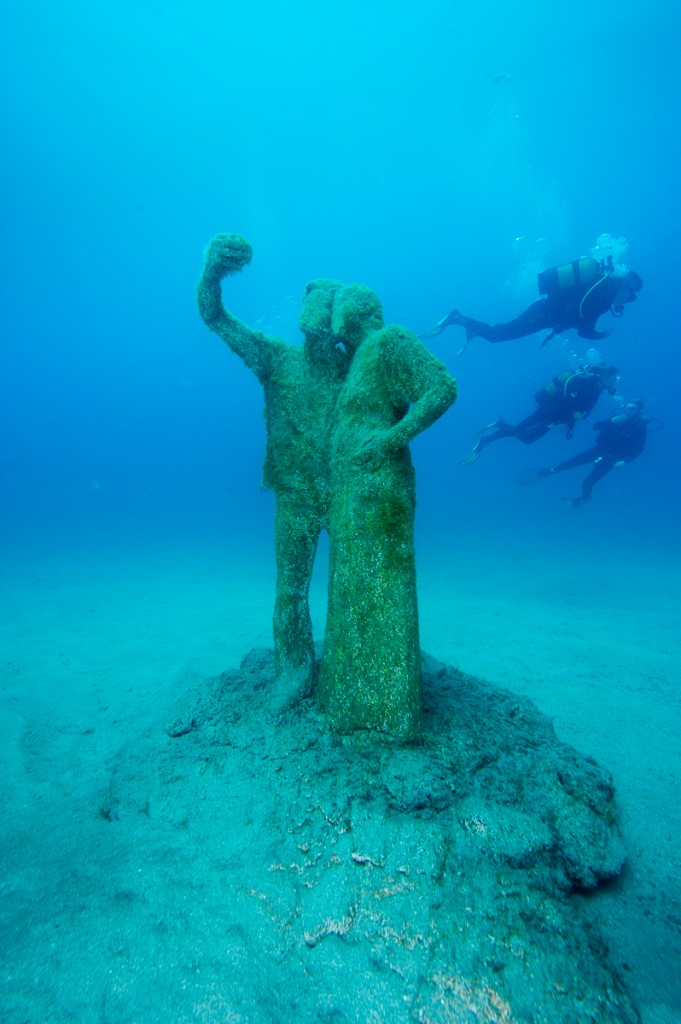 Arthur and I had been diving all week with Safari Diving out of Puerto del Carmen and had been recommended to book our Museum dive with The Dive College. Situated on the south west end of Lanzarote, there are a limited number of licensed dive centres with permits to take divers to the Museum. Each diver must pay a 7 euro entrance fee in addition to the cost of the dive, which tends to cost a little more than a regular dive on the island. Being a shallow dive it’s suitable for divers of all skill levels.
Arthur and I had been diving all week with Safari Diving out of Puerto del Carmen and had been recommended to book our Museum dive with The Dive College. Situated on the south west end of Lanzarote, there are a limited number of licensed dive centres with permits to take divers to the Museum. Each diver must pay a 7 euro entrance fee in addition to the cost of the dive, which tends to cost a little more than a regular dive on the island. Being a shallow dive it’s suitable for divers of all skill levels.
The museum has been designed and created by British artist Jason deCaires Taylor, who has also created similar amazing projects in Mexico, Grenada, and the Bahamas. The sculpture park in Grenada, which was the first of its kind in the world, has been listed as one of National Geographic’s Top 25 Wonders of the World; while most recently, “Ocean Atlas”, Taylor’s Bahamas creation, is the largest single underwater sculpture in the world, measuring 5 meters high and weighing over 60 tons.
Taylor’s statues are made up of a mixture of ingredients including wire and concrete, and are situated on sandy bottoms waiting to be transformed into completely new ecosystems, breathing rich new life into an area of low diversity.
The Atlantic Museum is best viewed as it is now by scuba diving, but soon areas will be created at shallower depths so snorkellers can easily swim down and enjoy the sculptures. As the museum grows and takes shape, a variety of very ambitious and exciting pieces will be added, including a giant mirror to create the illusion of a ‘pool’ in the sea, a large wall to create the walled garden, and an underwater fountain complete with actual lighting as its centrepiece.
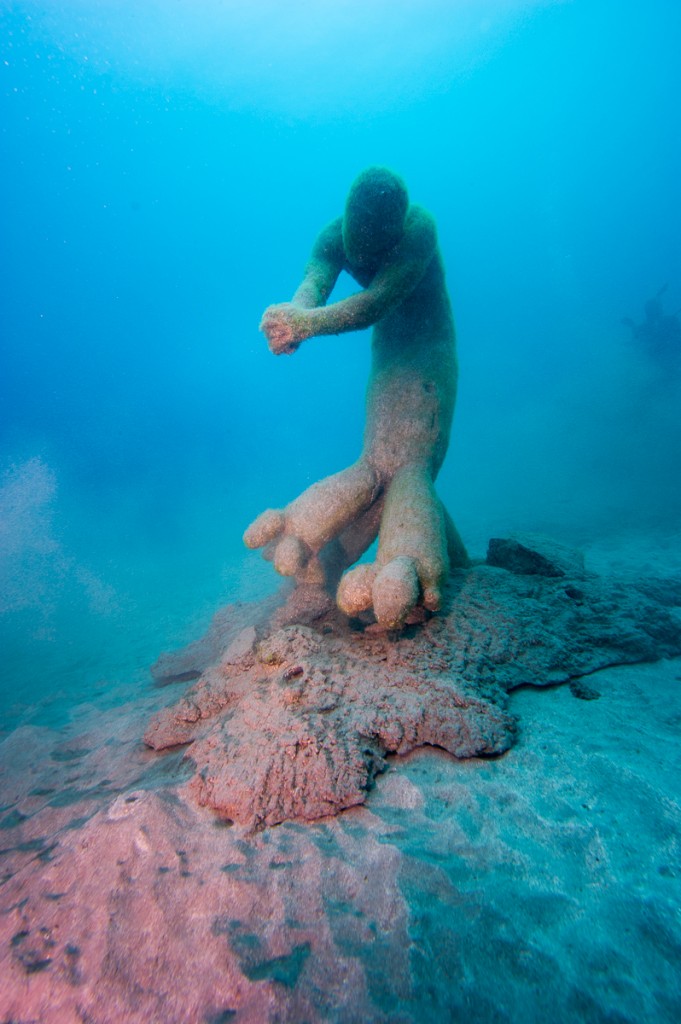 As we left the amazing statues of men, women and children, we followed our guide into what we were told in our pre-dive briefing will be the amazing garden area. In this spot there were already a number of fascinating statues. Half human, half plant, we swam over to a series of giant cacti. Some had human heads, some didn’t. One was clasping its hands with its arms stretched out – like a gardener tending to his crops – his feet forming part of a cactus.
As we left the amazing statues of men, women and children, we followed our guide into what we were told in our pre-dive briefing will be the amazing garden area. In this spot there were already a number of fascinating statues. Half human, half plant, we swam over to a series of giant cacti. Some had human heads, some didn’t. One was clasping its hands with its arms stretched out – like a gardener tending to his crops – his feet forming part of a cactus.
The Atlantic Museum project is massive. Originally 500 statues were planned at a cost of 700,000 euros of public funding. There was some controversy regarding the cost, and perhaps due to complaints things have been held up, as to date only 50-odd statues have been sunk. Due to statues only being permitted to be sunk in the winter season, no more are planned till later this year; but when it is finally completed, Lanzarote’s Underwater Museum will be fabulous and a real boost for tourism on the island (especially for Playa Blanca).
We were at the end of our tour and had reached what was undoubtedly my favourite piece. I’m not sure if it’s actually called the Tree of Life, but that’s what I would have called it. An artificial tree reaching up to the sky, it was home to hundreds of tiny fish taking shelter within its branches, feeding on the algae already beginning to cover it. Like tiny little lights, the fish reflected and bounced light all around the tree, making it look like it was being illuminated by loads of tiny fairy lights blinking off and on as the fish turn one way and the next. A lone predator watched them, waiting to pounce; it must have swum by and chanced upon this oasis in the desert.
Taylor’s pioneering projects have become hugely successful in terms of marine conservation, stimulating people to engage and become aware of the need to protect our fragile marine world. His creations are works of art that grow and change as the marine world shapes them, colours them and adds to their beauty. It will be interesting to see when his Atlantic Museum is finally finished – and where Taylor’s next project will take him.
Read Gavin’s article about diving other parts of Lanzarote here.
All of Gavin’s diving was arranged by Safari Diving Lanzarote.
Gear News
Scubapro Free Octopus Promotion 2024

Free Octopus with every purchase of a SCUBAPRO regulator system
Just in time for the spring season, divers can save money with the FREE OCTOPUS SPRING PROMOTION! Until July 31st SCUBAPRO offers an Octopus for free
with every purchase of a regulator system!
Get a free S270 OCTOPUS with purchase of these combinations:
MK25 EVO or MK19 EVO with A700
MK25 EVO or MK19 EVO with S620Ti
MK25 EVO or MK19 EVO with D420
MK25 EVO Din mit S620Ti-X
Get a free R105 OCTOPUS with purchase of the following combinations:
MK25 EVO or MK19 EVO with G260
MK25 EVO or MK17 EVO with S600
SCUBAPRO offers a 30-year first owner warranty on all regulators, with a revision period of two years or 100 dives. All SCUBAPRO regulators are of course certified according to the new European test standard EN250-2014.
Available at participating SCUBAPRO dealers. Promotion may not be available in all regions. Find an authorized SCUBAPRO Dealer at scubapro.com.
More information available on www.scubapro.com.
Blogs
Northern Red Sea Reefs and Wrecks Trip Report, Part 3: The Mighty Thistlegorm

Jake Davies boards Ghazala Explorer for an unforgettable Red Sea diving experience…
Overnight, the wind picked up, making the planned morning dive a bit bumpy on the Zodiacs to the drop point on Thomas Reef. There, we would dive along the reef before descending through the canyon and then passing under the arch before ascending the wall with a gentle drift. The site provided great encounters with more pelagic species, including shoals of large barracuda, tuna, and bigeye trevally.
Once back on the boat, it was time to get everything tied down again as we would head back south. This time, with the wind behind us, heading to Ras Mohammed to dive Jackfish Alley for another great gentle drift wall dive before then heading up the coast towards the Gulf of Suez to moor up at the wreck of the Thistlegorm. This being the highlight wreck dive of the trip and for many onboard, including myself, it was the first time diving this iconic wreck. I had heard so much about the wreck from friends, and globally, this is a must on any diver’s list. Fortunately for us, there was only one other boat at the site, which was a rarity. A great briefing was delivered by Ahmed, who provided a detailed background about the wreck’s history along with all the required safety information as the currents and visibility at the site can be variable.

Kitting up, there was a lot of excitement on deck before entering the water and heading down the shoreline. Descending to the wreck, there was a light northerly current which reduced the visibility, making it feel more like the conditions that can be found off the Welsh coast. At 10m from the bottom, the outline of the wreck appeared as we reached the area of the wreck which had been bombed, as our mooring line was attached to part of the propeller shaft. Arriving on deck, instantly everywhere you looked there were many of the supplies which the ship was carrying, including Bren Carrier tanks and projectiles that instantly stood out.

We headed around the exterior, taking a look at the large propeller and guns mounted on deck before entering the wreck on the port side to take a look in the holds. It was incredible to see all the trucks, Norton 16H, and BSA motorcycles still perfectly stacked within, providing a real snapshot in time.

Overall, we had four dives on the Thistlegorm, where for all of the dives we were the only group in the water, and at times, there were just three of us on the whole wreck, which made it even more special, especially knowing that most days the wreck has hundreds of divers. Along with the history of the wreck, there was plenty of marine life on the wreck and around, from big green turtles to batfish, along with shoals of mackerel being hunted by trevally. Some unforgettable dives.

The final leg of the trip saw us cross back over the Suez Canal to the Gobal Islands where we planned to stay the night and do three dives at the Dolphin House for the potential of sharing the dive with dolphins. The site, which included a channel that was teeming with reef fish, especially large numbers of goatfish that swam in large shoals along the edge of the reef. These were nice relaxing dives to end the week. Unfortunately, the dolphins didn’t show up, which was okay as like all marine life they are difficult to predict and you can’t guarantee what’s going to be seen. With the last dive complete, we headed back to port for the final night where it was time to clean all the kit and pack before the departure flight the next day.

The whole week from start to finish on Ghazala Explorer was amazing; the boat had all the facilities you need for a comfortable week aboard. The crew were always there to help throughout the day and the chefs providing top quality food which was required after every dive. The itinerary providing some of the best diving with a nice mixture of wreck and reef dives. I would recommend the trip to anyone, whether it’s your first Red Sea liveaboard in the Red Sea or you’re revisiting. Hopefully, it’s not too long before I head back to explore more of the Red Sea onboard Ghazala Explorer.

To find out more about the Northern Red Sea reef and wrecks itineraries aboard Ghazala Explorer, or to book, contact Scuba Travel now:
Email: dive@scubatravel.com
Tel: +44 (0)1483 411590
Photos: Jake Davies / Avalon.Red
-

 News3 months ago
News3 months agoHone your underwater photography skills with Alphamarine Photography at Red Sea Diving Safari in March
-

 News3 months ago
News3 months agoCapturing Critters in Lembeh Underwater Photography Workshop 2024: Event Roundup
-

 Marine Life & Conservation Blogs2 months ago
Marine Life & Conservation Blogs2 months agoCreature Feature: Swell Sharks
-

 Blogs2 months ago
Blogs2 months agoMurex Resorts: Passport to Paradise!
-

 Blogs2 months ago
Blogs2 months agoDiver Discovering Whale Skeletons Beneath Ice Judged World’s Best Underwater Photograph
-

 Gear Reviews3 months ago
Gear Reviews3 months agoGear Review: Oceanic+ Dive Housing for iPhone
-

 Marine Life & Conservation2 months ago
Marine Life & Conservation2 months agoSave the Manatee Club launches brand new webcams at Silver Springs State Park, Florida
-

 News3 months ago
News3 months agoWorld’s Best Underwater Photographers Unveil Breathtaking Images at World Shootout 2023


